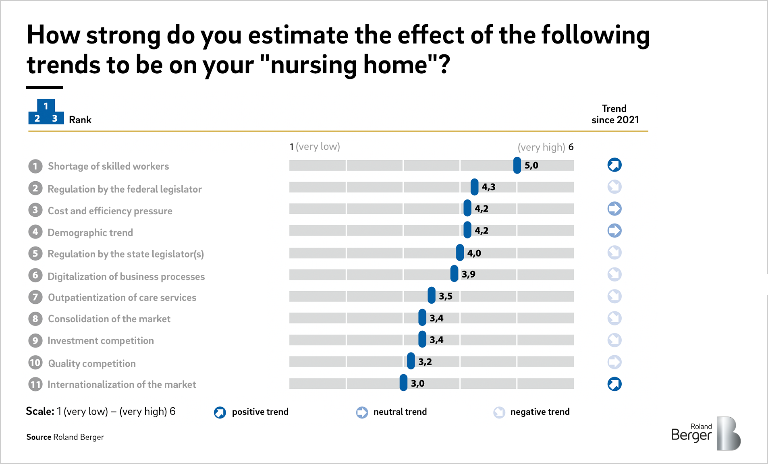Due to the increasing need for digitization, hospitals are expected to incur additional expenses of more than 10 percent.


CARE Monitor 2022 – On the pulse of the nursing sector
Skills shortage and funding problems remain an issue
In the current CARE Monitor 2022, Roland Berger and CARE INVEST are investigating the central trends and challenges in the nursing sector, which continues to be heavily affected by the COVID-19 pandemic, for the third time already. The focus this time is on the development of the shortage of skilled workers and its effects on the entire sector.

"A modern HR strategy focuses on employee appreciation and development. The basis for this must be an authentic leadership culture."
The analysis is based on historical collections of data as well as the surveying of 230 German companies in the nursing sector. As already found in the early studies, the shortage of skilled workers remains the biggest challenge. However, a long-term solution to this requires the joint efforts of companies in the nursing sector as well as society and politics in order to develop a new conception of work in the nursing sector that is fit for the future. Successful HR management that puts the focus on people will therefore continue to be the key factor for success in the nursing sector.
The shortage of skilled workers has intensified due to the COVID-19 pandemic
In comparison to CARE Monitor 2021, the significance of the shortage of skilled workers in nursing professions continues to be increasing. Around 75 percent of those surveyed stated that the situation has intensified once again since 2021 and the shortage of skilled workers is the biggest problem and a key hindrance to growth. In addition to the changing age structure of the population and the associated reduction of available workers, this trend is also driven by lack of recognition within the profession. It is therefore not surprising that fewer and fewer people are considering training in a nursing profession and the labor market is thinning out further. The introduction of compulsory vaccination for nursing staff since March 15, 2022, is additionally intensifying the problem. Over 13 percent of the facilities cannot implement the compulsory vaccination for their employees. Small-scale and East German care homes are affected by this most of all - they expect a loss of human resources of over six percent in comparison to 2021.
This development clearly shows that successful HR management has become a top management task and a key factor for success in the battle over the shortage of staff. The solution: Many facilities want to become more attractive as employers in order to gain new nursing staff. In their recruiting they use both digital channels (e.g. Facebook, Instagram, LinkedIn) as well as conventional marketing measures for the communication of their employer brand. The use of the various marketing tools primarily depends on the financial capabilities and size of the facility. Large operator groups focus more intensively on digital marketing than small facilities. After all, human resources are one of the most important stakeholders in the nursing sector. A sustainable work-life balance continues to be decisive for long-term staff retention. Reliable shift scheduling is at the very top of the agenda for this. In addition, all stakeholders are in agreement that the regular adjustment of the remuneration structure will remain a key issue in the future as well.
Turnover increases are expected in 2022, but HR costs are negatively impacting earnings
The negative effects on the development of turnover due to the COVID-19 crisis are lessening in the meantime and nearly one out of every two companies expects an increase of turnover in 2022 in comparison to the previous year. However, more than one-third of those surveyed assume that 2022 will be closed with a deficit - the highest rate since CARE Monitor began. This is not least due to increased HR costs of 6.8 percent in the meantime (in CARE Monitor 2021 they were 6.2%). The reason: Due to the shortage of skilled workers, the market for nursing professions in hospital and geriatric care already developed into an employee's market long ago. The forecast for the HR cost increases in the coming five years accordingly amounts to 5.8 percent per year.
This also has significant impacts on the amount of the facility-wide co-payment or "EEE" (amount of nursing expenses that the residents of care facilities must pay themselves for their care). According to the survey, the facility-wide co-payment or "EEE" will increase by an average of EUR 150 to 200 in 2022 for the refinancing of the increased nursing staff costs. However, this increase only covers 81 percent of the HR cost increases and thereby places additional pressure on the companies. In order to close this financing gap, additional services beyond conventional care services are being offered more intensively and are intended to thereby contribute to improving the economic situation. In parallel, costs are being reduced further: 62 percent of companies want to cut down on the costs of materials in particular, i.e. through the formation of purchasing pools. Cutting down on HR costs, in contrast, is not an option in view of the shortage of skilled workers.
Digitalization continues to lag behind
The measures for the digitalization of the nursing sector are currently focused on the simplification of the existing administrative processes within the companies. A rethinking of the processes with the involvement of the employees and residents is not the focus as of yet. The current digitalization projects are being financed with two to five percent of the turnover per year. However, 48 percent believe that this amount is insufficient for a comprehensive digitalization strategy. Together with the extensive data protection requirements, the high need for investment is the second big hurdle for the implementation of digital projects. The biggest problem is currently the lack of standardization of interfaces between the different IT systems. The acceptance of digital solutions among the care-dependent and among nursing staff, in contrast, has risen continuously in recent years and is therefore not the reason for the lagging digital transformation.
Three important fields of action will determine the future
Even if the sector continues to be on a course of growth due to the demographic trend, the course must be set for the future now. Roland Berger's experts see three important fields of action for this:
1. Appreciation of the workers in the nursing sector
- Development and implementation of an HR strategy and improvement of the working conditions for skilled workers in the nursing sector.
- Establishment of an attractive work-life balance to increase employer attractiveness
- Communication of appreciation and offering of new development opportunities for workers
2. Reduction of the costs of materials
- Optimization of procurement through the streamlining of complexity or use of scaling effects via purchasing pools
- Outsourcing of services to increase the demand for services outside of the core business
3. Rethinking digitalization
- Use of digital services for the networking of external partners and cooperations with hospitals, pharmacies, or medical practices
- Evaluation of digital medical services, e.g. telemedicine










